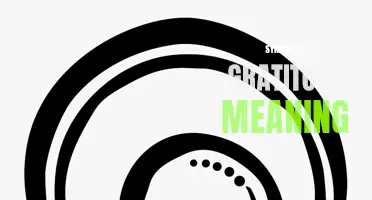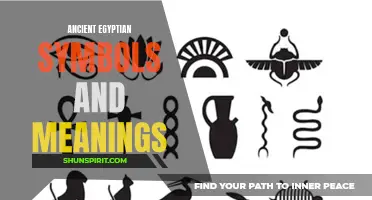
When we hear the word griffin, our minds may conjure images of a mythical creature, one that combines the body of a lion with the head and wings of an eagle. But beyond its fantastical appearance, the griffin holds significant symbolism throughout history. From ancient legends to modern interpretations, the griffin symbolizes strength, nobility, and majestic power. Its iconic presence in art, literature, and heraldry has captivated the imaginations of countless individuals, making it a captivating emblem of greatness. So, let us delve into the rich symbolism of the griffin and explore the intriguing meanings behind this legendary creature.
What You'll Learn
- What is the origin of the griffin symbol and what does it represent in different cultures?
- How has the meaning of the griffin symbol evolved over time?
- What are some common interpretations or associations of the griffin symbol in mythology and literature?
- Are there any specific regions or civilizations that particularly emphasized the griffin symbol in their art or symbolism?
- Can the griffin symbol be interpreted differently in different contexts, and if so, what factors influence its meaning?

What is the origin of the griffin symbol and what does it represent in different cultures?
The griffin is a mythical creature that has been depicted in various forms and has held different meanings in different cultures throughout history. The origins of the griffin symbol can be traced back to ancient Egypt and Mesopotamia, where it was believed to be a guardian of sacred treasures and a symbol of divine power.
In ancient Egypt, the griffin was often portrayed as a creature with the body of a lion and the head and wings of an eagle. It was associated with the sun god Ra and was believed to possess the ability to fly between the earth and the heavens. The griffin was seen as a protector of the pharaoh and his kingdom and was often depicted on tombs and monuments.
In ancient Mesopotamia, the griffin was known as the "karibu" and was associated with the god Ningirsu. It was believed to be a guardian of the gates of temples and palaces and was often depicted in various art forms, such as carvings and statues. The griffin was also seen as a symbol of fertility and was associated with the goddess Ishtar.
In Greek mythology, the griffin, or "gryphon", was depicted as a creature with the body of a lion and the head and wings of an eagle. It was seen as a guardian of gold and other precious treasures, and was often depicted in sculptures, paintings, and other forms of art. The griffin was also believed to be a protector of the divine and a symbol of strength and ferocity.
In medieval Europe, the griffin continued to be associated with protection and power. It was often used as a symbol on coats of arms and heraldic devices. The griffin was seen as a noble creature, representing courage and virtue, and was often associated with royalty and the ruling elite.
Overall, the griffin symbol has held different meanings in different cultures, but it has generally been associated with power, protection, and divine connection. It has been revered as a guardian of sacred places and treasures, as well as a symbol of strength and nobility. The griffin continues to be a popular symbol in modern times, often depicted in art, literature, and popular culture.
Cracking the Code: The Meaning Behind Air Conditioner Symbols
You may want to see also

How has the meaning of the griffin symbol evolved over time?
The griffin is a mythological creature that has been depicted in various cultures throughout history. It is a symbol that has evolved over time, taking on different meanings and interpretations. In this article, we will explore the evolution of the griffin symbol and its significance in different contexts.
In ancient times, the griffin was predominantly associated with the ancient Greeks. It was believed to be a creature with the body of a lion and the head and wings of an eagle. The griffin was often depicted as a guardian of treasures and important artifacts. It was said to be a creature of immense strength and power, capable of protecting valuable possessions from thieves and intruders.
As time passed, the griffin symbol spread to other cultures and regions, including the ancient Persians and Egyptians. In Persian mythology, the griffin was seen as a symbol of justice and divine power. It was often depicted alongside images of kings and rulers, signifying their authority and legitimacy. The griffin was also associated with the sun and was believed to be a messenger of the gods.
In Egyptian mythology, the griffin was known as the "gryphos" and was often depicted as a guardian of the gods and their temples. It was a symbol of protection and was believed to ward off evil spirits and negative energies. The griffin was also associated with the sun in Egyptian culture, representing rebirth and renewal.
During the medieval period, the griffin symbol took on new meanings and interpretations. It became closely associated with Christian symbolism, often representing divine blessings and protection. The church used the griffin as a symbol of Christ's dual nature, embodying both the divine and the human. It was seen as a representation of the guardian and protector of the Christian faith.
In heraldry, the griffin became a popular symbol, often used on coats of arms and crests. It was seen as a symbol of courage, bravery, and nobility. The griffin's fierce nature and protective instincts made it a fitting symbol for knights and warriors.
In more modern times, the griffin symbol has been incorporated into popular culture and fantasy literature. The creature is often seen in fantasy novels, video games, and movies, where it is portrayed as a powerful and majestic creature. In these contexts, the griffin represents strength, wisdom, and the ability to overcome challenges.
In conclusion, the meaning of the griffin symbol has evolved over time, taking on different interpretations and associations in various cultures and contexts. From being a guardian of treasures in ancient Greece to a symbol of divine power in ancient Persia and Egypt, the griffin has represented a range of concepts and values. Today, it continues to be a popular symbol in popular culture, embodying strength, wisdom, and nobility.
Understanding the Symbols on Your AC Remote: Decoding Their Meanings
You may want to see also

What are some common interpretations or associations of the griffin symbol in mythology and literature?
The griffin, a mythical creature with the body of a lion and the head and wings of an eagle, is a symbol that has been present in various mythologies and literatures throughout history. This majestic creature has long captivated the imagination of humans and has come to represent a variety of virtues and concepts.
One of the most common interpretations of the griffin symbol is that it represents strength and power. As a combination of the king of beasts and the king of birds, the griffin is seen as a creature of immense physical prowess. In mythology, the griffin is often portrayed as a guardian of treasure or sacred places, using its strength to protect what is valuable. This association with strength and power has made the griffin a popular symbol in heraldry and other forms of symbolic representation.
Another interpretation of the griffin symbol is that it represents nobility and royalty. In ancient Greek and Roman mythology, the griffin was associated with Apollo, the god of music and poetry, and was believed to be a creature of great dignity and grandeur. As a result, the griffin became a symbol of the divine and was often associated with royalty and the gods.
In addition to its associations with strength and nobility, the griffin is also often seen as a symbol of intelligence and wisdom. The combination of the lion and the eagle, two creatures that are traditionally associated with these qualities, makes the griffin a creature of great knowledge and insight. In literature, the griffin is often depicted as a wise and trusted advisor, offering guidance and knowledge to those who seek it.
The griffin is also sometimes associated with protection and watchfulness. In many mythological tales, the griffin is portrayed as a guardian or protector, standing watch over something or someone of importance. This association with protection has made the griffin a popular symbol in architecture, where it is often seen perched on buildings and walls as a symbol of security and safety.
Overall, the griffin symbol holds a variety of interpretations and associations. From its representation of strength and power to its associations with nobility, intelligence, and protection, the griffin has become a prominent and highly regarded mythical creature in various mythologies and literatures throughout history. Its ability to embody a diverse range of virtues and concepts has made it a beloved and enduring symbol in human culture.
Unveiling the Hidden Meanings Behind Pokemon Symbols
You may want to see also

Are there any specific regions or civilizations that particularly emphasized the griffin symbol in their art or symbolism?
Griffins are mythical creatures that have the body of a lion and the head and wings of an eagle. They have been depicted in various forms of art and symbolism throughout history. While griffins can be found in the folklore and mythology of many different cultures, there are a few regions and civilizations that particularly emphasized the griffin symbol in their art and symbolism.
One such region is ancient Greece. In Greek mythology, griffins were associated with the god Apollo, who often used them as his messengers. They were considered as powerful and majestic creatures that protected divine secrets. The griffin symbol was often used in Greek art and sculpture, appearing on pottery, jewelry, and even architectural elements. This symbol not only represented the strength and power of the creature but also conveyed a sense of divine protection and guidance.
Another civilization that emphasized the griffin symbol in its art and symbolism was ancient Persia. In Persian mythology, griffins were the guardians of treasure and were often depicted as protectors of the royal throne. They were seen as symbols of strength, courage, and wisdom. The Persian Empire extensively used the griffin symbol in their artwork, especially in their architecture and textiles. The griffin motif could be found in palaces, temples, and even on the clothing of royalty, symbolizing their divine right to rule.
In addition to ancient Greece and Persia, the griffin symbol also had significance in ancient Egypt. While not as prominent as in Greek or Persian culture, griffins were depicted in Egyptian art as beings that possessed both strength and intelligence. They were often associated with the sun god Ra, who was believed to have the head of an eagle and the body of a lion. The griffin symbol could be seen on temple walls and jewelry, representing protection and divine power.
Overall, the griffin symbol has been utilized by various regions and civilizations throughout history. Whether as protectors of the divine, guardians of treasure, or symbols of power and wisdom, griffins have left their mark on the art and symbolism of ancient Greece, Persia, and Egypt. The combination of the lion's strength and the eagle's grace has made the griffin a powerful and enduring symbol in human culture.
Brotherly Bond: Unpacking the Symbols That Represent Brotherhood
You may want to see also

Can the griffin symbol be interpreted differently in different contexts, and if so, what factors influence its meaning?
The griffin symbol, often depicted as a creature with the body of a lion and the head and wings of an eagle, has been used in various contexts throughout history. This legendary creature has appeared in diverse cultures and is known for its symbolism of strength, power, and protection. However, the interpretation of the griffin symbol can vary depending on the context in which it is used, and several factors can influence its meaning.
One factor that influences the interpretation of the griffin symbol is cultural context. Different cultures and civilizations have incorporated the griffin symbol into their mythology and folklore, attributing unique meanings to it. In ancient Greek mythology, for example, the griffin was seen as a guardian of treasure and was associated with the god Apollo. In Persian mythology, the griffin symbolized wisdom and was believed to be the embodiment of divine power. These cultural associations shape how the griffin symbol is perceived and understood within specific contexts.
Another factor that can influence the interpretation of the griffin symbol is its depiction in art and architecture. The way the griffin is portrayed, whether it is shown alone or in combination with other symbols, can affect its meaning. For instance, when the griffin is depicted with a sword, it may symbolize bravery and the defense of justice. On the other hand, when the griffin is shown with a key, it can represent protection and access to hidden knowledge. These visual cues help to convey additional layers of meaning and further contextualize the symbol.
Furthermore, the historical context in which the griffin symbol is used can also shape its interpretation. Throughout history, the griffin has been associated with powerful figures, such as kings and emperors, who used it as a symbol of their authority and dominion. In this context, the griffin can represent leadership, control, and the divine right to rule. However, in modern times, the griffin symbol has been adopted by various organizations, such as sports teams and schools, and its meaning may be more focused on attributes like strength, competitiveness, and teamwork.
In conclusion, the griffin symbol can be interpreted differently in different contexts, and several factors influence its meaning. Cultural context, artistic depiction, and historical context all play a role in shaping how the griffin symbol is understood. Whether it represents protection, wisdom, power, or another attribute, the griffin symbol continues to be a fascinating and versatile emblem that has captured the imagination of people throughout the ages.
Decoding the Symbolic Meanings of Honda Accord's Iconic Emblem
You may want to see also
Frequently asked questions
The griffin symbol is often associated with strength, power, and courage. It is a mythical creature that is a combination of a lion and an eagle, representing both land-based and sky-based qualities. In many cultures, the griffin is seen as a guardian and protector, symbolizing the ability to overcome challenges and protect what is important.
The griffin symbol has its origins in ancient mythology and can be found in various cultures. It is often associated with ancient Greece and Persia, where it was believed to guard treasure and protect sacred spaces. The griffin symbol later spread to medieval Europe and became a popular motif in heraldry and architectural decoration.
The lion body of the griffin symbolizes strength, ferocity, and bravery. Lions are often seen as the kings of the animal kingdom, representing leadership and dominance. By incorporating the lion's body into the griffin symbol, it adds a sense of power and authority to the creature.
The eagle head of the griffin symbolizes wisdom, keen vision, and a connection to the heavens. Eagles are often associated with soaring high above, surveying the land below, and symbolize a broader perspective and insight. By combining the eagle's head with the lion's body, the griffin symbol encompasses both earthly and celestial qualities.
The griffin symbol continues to be used today in various ways. It can be found in architecture, sculptures, and artwork, often as a symbol of strength and protection. The griffin is also used in corporate logos, representing companies that strive for power, dominance, and excellence. In literature and popular culture, the griffin is often depicted as a majestic and mythical creature, embodying a sense of adventure and fantasy.







